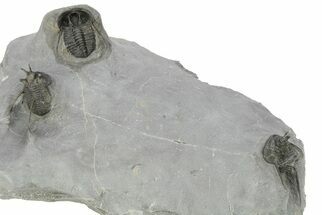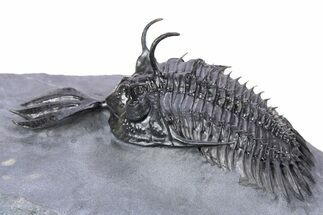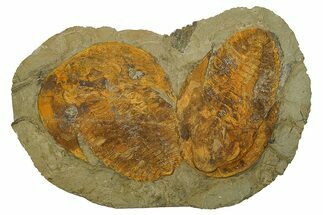2.5" Short Trident Walliserops Trilobite - Timrzit, Morocco
This bizarre specimen is the "short trident" version of Walliserops. This specimen is wonderfully prepared with nearly 50 small, free-spines. There is beautiful eye facet preservation in this specimen. This specimen would be about 2.5" long if it was fully outstretched which is about average in size for the species.
There are at least four described species of Walliserops and several currently undescribed ones. This appears very similar to Walliserops lindoei described from another location, though the trident is slightly different. Whether this one will eventually get it's own species or be grouped in the Walliserops lindoei is yet to be determined. The paper describing Walliserops lindoei can be found below.
LATEST EARLY TO EARLY MIDDLE DEVONIAN TRILOBITES FROM THE ERBENOCHILE BED, JBEL ISSOUMOUR, SOUTHEASTERN MOROCCO
There are at least four described species of Walliserops and several currently undescribed ones. This appears very similar to Walliserops lindoei described from another location, though the trident is slightly different. Whether this one will eventually get it's own species or be grouped in the Walliserops lindoei is yet to be determined. The paper describing Walliserops lindoei can be found below.
LATEST EARLY TO EARLY MIDDLE DEVONIAN TRILOBITES FROM THE ERBENOCHILE BED, JBEL ISSOUMOUR, SOUTHEASTERN MOROCCO
Walliserops is a fascinating ancient arthropod that scoured the bottom of a shallow sea floor. It is placed in a genus of spiny, phacopid (acastid) trilobites and it is found in Lower to Middle Devonian (441-358 mya) rocks from Morocco. All species of Walliserops share the spectacular three-pronged "trident" that rises from the glabella. They also have horns over their eyes and intimidating spines along their backs.
Walliserops was highly specialized to deal with an oceanic wonderland in the diverse and dangerous Age of Fish. Specialization is a key difference from the more primitive “bugs” that emerged in the Cambrian.
Walliserops displays an unusual departure from bilateral symmetry. A notable example is the curved occipital spine of W. hammii, which takes a noticeable curl to one side. The regular development of these features in multiple specimens suggests a genetically controlled feature of the genus, not mutation or pathology. Some exceptions to bilateral symmetry can be explained by adaptations that allowed the trident to be held off the sea floor while walking.
The trident's function is an intriguing mystery. Many believe it was used to stir the ocean floor to better scavenge for food. Such a large adornment would have required significant energy and nutrient investment. Although a number of suggestions have been made (e.g. sensory apparatus, disguise or protection), many experts support an idea that the trident served as "horns" similar to present day beetles.
Morroco is an exciting place for discovering new and diverse species that lived in an ancient ocean that covered the northern reaches of the Sahara Desert. All three currently described Walliserops species come from the same strata near Foum Zguid in southern Morocco, though other locations have yielded new trilobites to study. This region is hailed as one of the great fossil treasure troves in the world.
Walliserops was highly specialized to deal with an oceanic wonderland in the diverse and dangerous Age of Fish. Specialization is a key difference from the more primitive “bugs” that emerged in the Cambrian.
Walliserops displays an unusual departure from bilateral symmetry. A notable example is the curved occipital spine of W. hammii, which takes a noticeable curl to one side. The regular development of these features in multiple specimens suggests a genetically controlled feature of the genus, not mutation or pathology. Some exceptions to bilateral symmetry can be explained by adaptations that allowed the trident to be held off the sea floor while walking.
The trident's function is an intriguing mystery. Many believe it was used to stir the ocean floor to better scavenge for food. Such a large adornment would have required significant energy and nutrient investment. Although a number of suggestions have been made (e.g. sensory apparatus, disguise or protection), many experts support an idea that the trident served as "horns" similar to present day beetles.
Morroco is an exciting place for discovering new and diverse species that lived in an ancient ocean that covered the northern reaches of the Sahara Desert. All three currently described Walliserops species come from the same strata near Foum Zguid in southern Morocco, though other locations have yielded new trilobites to study. This region is hailed as one of the great fossil treasure troves in the world.
SPECIES
Walliserops aff. lindoei
LOCATION
Timrzit, Morocco
SIZE
2.5" long (if outstretched)
CATEGORY
SUB CATEGORY
ITEM
#179515
We guarantee the authenticity of all of our specimens.
 Reviews
Reviews














